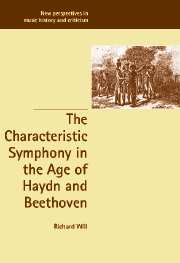Book contents
- Frontmatter
- Contents
- Acknowledgments
- Note to the reader
- Introduction
- 1 Paradise lost: Dittersdorf's Four Ages of the World and the crisis of Austrian enlightened despotism
- 2 Preaching without words: Reform Catholicism versus divine mystery in Haydn's Seven Last Words
- 3 The boundaries of the art: characteristic music in contemporary criticism and aesthetics
- 4 Paradise regained: time, morality, and humanity in Beethoven's Pastoral Symphony
- 5 Making memories: symphonies of war, death, and celebration
- Appendixes
- Bibliography
- Index
3 - The boundaries of the art: characteristic music in contemporary criticism and aesthetics
Published online by Cambridge University Press: 11 January 2010
- Frontmatter
- Contents
- Acknowledgments
- Note to the reader
- Introduction
- 1 Paradise lost: Dittersdorf's Four Ages of the World and the crisis of Austrian enlightened despotism
- 2 Preaching without words: Reform Catholicism versus divine mystery in Haydn's Seven Last Words
- 3 The boundaries of the art: characteristic music in contemporary criticism and aesthetics
- 4 Paradise regained: time, morality, and humanity in Beethoven's Pastoral Symphony
- 5 Making memories: symphonies of war, death, and celebration
- Appendixes
- Bibliography
- Index
Summary
The subtitle of Beethoven's Pastoral Symphony, “More the expression of emotions than painting,” reveals two curious facts about characteristic music. Long before the nineteenth century put the Pastoral on stage or discovered extra birds in its second movement (see p. 18 above), attaching texts to instrumental works raised expectations that physical objects or events would be represented, whatever the stated subject. Beethoven was not alone in trying to challenge the assumption; Hermes, too, begins his Analyse of Dittersdorf's Metamorphoses by declaring that they are not “imitations de la nature” but “le résultat de ce que le compositeur a senti chaque fois lorsque frappé de la lecture d'un poème d'Ovide, il a versé sur le papier le feu dont il se trouvoit enflammé” (the result of that which the composer felt each time that he, struck by the reading of a poem of Ovid, set onto paper the fire in which he found himself enflamed). The music is said to embody passion, feeling, creative rapture, anything but physical nature, for that – and here is the second fact – would invite criticism. Adherents to the doctrine of mimesis in the eighteenth century felt that “tone-painting” literally transgressed the boundaries of music, appropriating practices more properly left to the other arts. The Romantics objected to its apparent materialism, the “reality” of Haydn's earthquake that so disturbed the Musikalisches Taschenbuch as it contemplated the otherwise “ideal” Seven Last Words (see p. 127 above).
- Type
- Chapter
- Information
- The Characteristic Symphony in the Age of Haydn and Beethoven , pp. 129 - 155Publisher: Cambridge University PressPrint publication year: 2002



